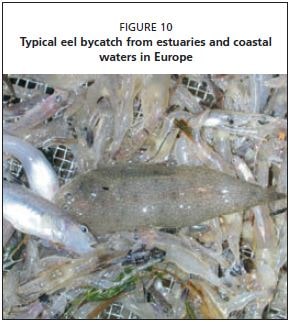ANTHROPOGENIC IMPACTS
Analysis of the recruitment trends in the northern part of the eel distribution area, and particularly in Sweden and in the Baltic area, show that recruitment and escape indicators started to decline well before the 1970s (Anonymous, 2002).
One of the major causes of declining populations is habitat fragmentation due to the construction of obstacles to eel migration. More than 25 000 dams were built worldwide in the twentieth century. In the European Union it is estimated that 60–65 percent of all rivers have some form of obstacle which restrict eel accessibility to the middle and upper reaches of the rivers. This effect has been experienced more severely in the peripheral zones of the eel distribution area, in particular in Scandinavia where hydroelectric facilities have been in place for many years. It is highly probable that these changes to the rivers had a catastrophic effect on the production of yellow and silver eel sub-adults. By the end of the 1940s this area alone experienced a marked reduction in small eels and a decreased in eel harvests in the Baltic a decade later.
In France, there has also been substantial disruption of rivers, including dams built near river mouths to prevent the tidal flow from moving upstream. These structures prevent glass eel from migrating upstream and increases the rate of exploitation of the fishery just underneath the dam, e.g. in the Vilaine estuary glass eel exploitation is >90 percent of the population (Anonymous, 2002).
The negative effect of these dams on eel production is exacerbated by water turbines that dramatically reduce the survival of silver eels during the downstream migration. Mortalities depend on the type of turbine used, the position of the water intake compared to the river axis, the presence of protective screens and hydrostatic pressure differences. The problem becomes particularly complicated when there are several hydroelectric power stations along the same river. Prignon, Micha and Gillet (1998) estimate that on the Meuse River direct mortality due to the migration through turbines was 34–45 percent for male eels and 40–63 percent for females. Donni, Maier and Vicenti, (2001) also showed that the cumulative eel mortality after the passage through 13 hydroelectric power stations on the Rhine is 92.7 percent. Eel survival is directly linked to free migration upstream and downstream.
The decrease in wetlands also impacts eels. Agricultural developments to increase water extraction or diversion for irrigation have caused severe degradation of lower drainage basin wetlands. It is estimated that between 30–40 percent of the 268 million hectares of cultivated land in the world are irrigated from surface water. In France the irrigated agriculture areas in the Garonne, Charente and Dordogne catchments have increased five-fold, from 100 000 hectares in 1970 to 500 000 hectares in 2000, while on the Adour the area increased four-fold (Teyssier et al., 2002; Prouzet, 2002, 2003a).
Development of agriculture on these wetlands has also been accompanied in the increase use of chlorobiphenyls, heavy metals, and organochlorinated pesticides which are easily accumulated in the fatty tissues of the eels. A study in Belgium showed that 80 percent of the eel samples examined exceeded the acceptable polychlorinated biphenyls (PCB) threshold of 75 µg/kg (Goemans and Belpaire, 2002). The impact of this contamination on the physiology of eel and, in particular, on its reproduction, remains undetermined.
The introduction of Anguilla japonica into the Mediterranean in the 1980s caused the appearance in Europe of the hematophagous
nematode Anguillicola crassus (Peters and
Hartmann, 1986). This nematode resides in the wall of the eel swim bladder and probably reduces its ability to ensure hydrostatic balance at the time of the migration towards the Sargasso Sea (Moller et al., 1991). The parasite is now widespread in Europe, with rates of infection of 55 percent in the Adour River (Anonymous, 1998) and close to 100 percent in many countries (Kennedy and Fitch, 1990). Fishing mortality varies according to country and river basin. The quantity of bycatch during glass eel fishing depends mainly of the location of the fishery, with greater bycatch in the marine environment than in brackish or freshwater. Most fishing boats are equipped with a sorting device which allows the removal of unwanted organisms (Figure 10). This kind of simple equipment limits the impact on non-target species.
FIGURE 10
Typical eel bycatch from estuaries and coastal waters in Europe
